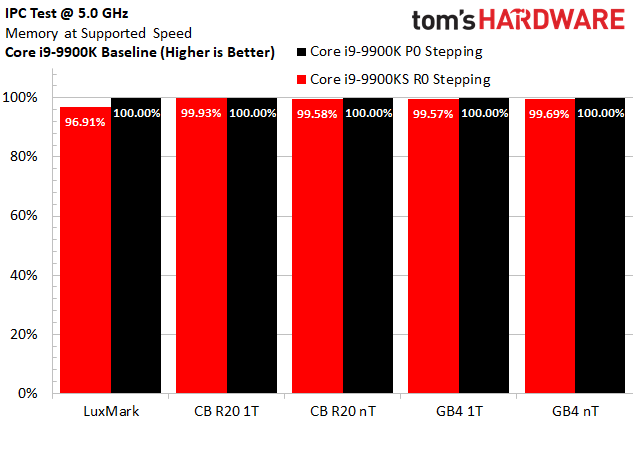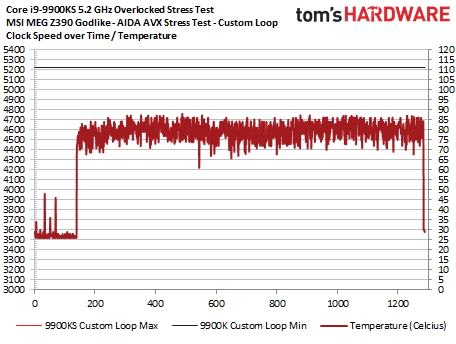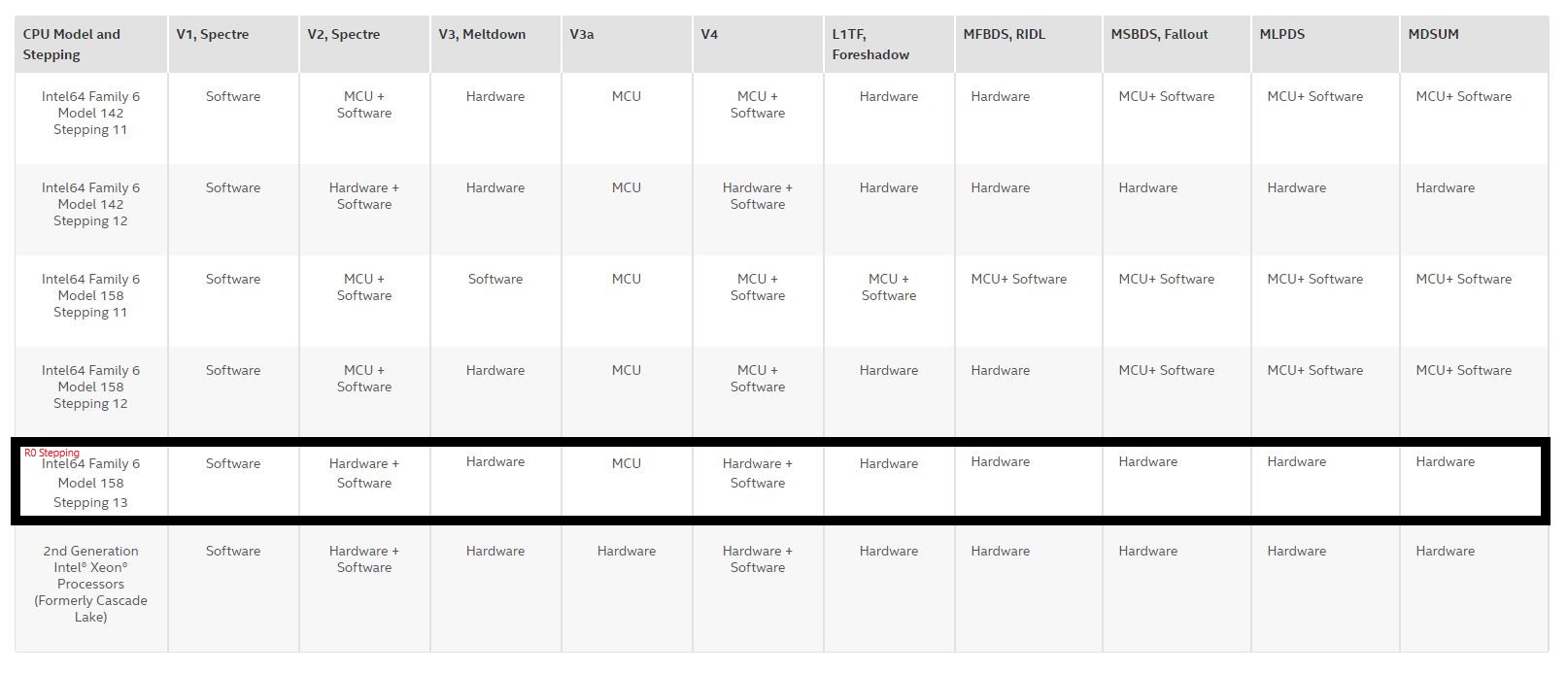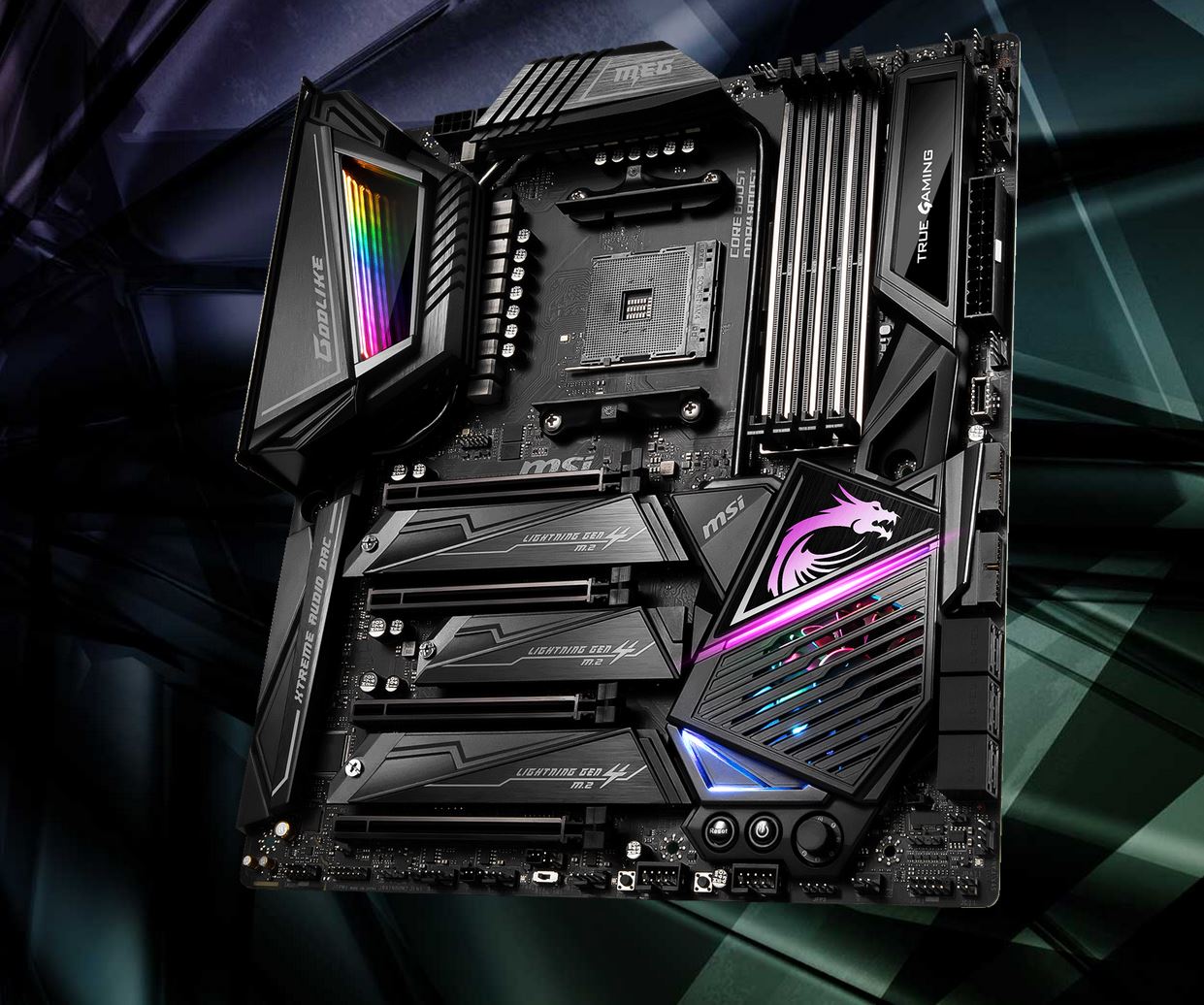Why you can trust Tom's Hardware
R0 versus P0 Stepping IPC Testing
Intel has added new hardware-based mitigations for many of the new vulnerabilities, like MSBDS, Fallout, and Meltdown, with new steppings of its die. Our Core i9-9900KS processor comes with the R0 stepping (Stepping 13), which stands in contrast to our -9900K model with the P0 stepping. It is noteworthy that newer ninth-gen Core models also ship with the P0 stepping. These in-built mitigations are designed to ease the performance overhead of software-based Windows security patches.
These in-silicon fixes have been rumored to impact instructions per cycle (IPC) throughput, and we logged a few performance regressions compared to the Core i9-9900K during our first round of tests. After re-flashing the motherboard BIOS and deploying a larger suite of tests, we found that the regressions weren't as pronounced as we initially recorded.
We set a static 5 GHz clock rate and dialed memory to the respective processors' supported frequency for the following tests:



As we can see, a few workloads do take a step backward, but most of the deltas fall within the expected run-to-run variance. Other workloads show slight gains. The LuxMark test registered a 4.5% standard deviation over our five test runs, meaning those results also fall within expectations given that that the test is inconsistent. As such, we will exclude that benchmark from future IPC testing. Our SHA-256 multi-threaded test represents the only significant outlier among the test suite that doesn't fall within the expected variance. It's important to remember that IPC can vary by workload, so dissimilar tasks may yield different outcomes.
However, we expect more pronounced performance improvements from the R0 silicon's in-built hardware mitigations. It's possible that these results could stem from motherboard firmware that isn't fully optimized. We have reached out to Intel for further information and will update as necessary.
Intel Core i9-9900KS Overclocking

We tested the Core i9-9900KS at stock settings with both a Corsair H115i cooler and a custom watercooling loop with an EKWB Supremacy Evo waterblock paired with two 360mm radiators to remove thermal limitations.
We saw little to no performance variation stemming from the different coolers at stock settings throughout the full breadth of our application testing suite.
Get Tom's Hardware's best news and in-depth reviews, straight to your inbox.
We easily attained a 5.2 GHz overclock with the custom loop, and temperatures hovered between ~75C and 85C during extended stress tests (above). We set vCore at 1.36V, tuned the memory to DDR4-3600, and adjusted Load Line Calibration on our MSI Z390 Godlike motherboard to Level 3. FCLK adjustments also help with stability, so we adjusted the setting to 1000 MHz.
We spent some time attempting to overclock with the Corsair H115i but didn't meet with much success as temperatures became a limiting factor. As such, we used the custom loop for our overclocking efforts in the test suite.
Overall, the Core i9-9900KS proved to be an easy overclocker, but as always, your mileage may vary. You'll pay a pretty penny for the Core i9-9900KS, but your odds of getting a cherry chip are certainly improved.
Our Test Sample
We used an independently-sourced Core i9-9900KS sample for our exclusive early testing article but expressed reservations because it appeared to be pre-production silicon. After further investigation, we learned that our sample is from a production batch. We also learned that MSI will not issue a new BIOS immediately following the -9900KS launch, meaning our initial test results with the publicly-available BIOS are valid and representative of performance with a shipping Core i9-9900KS processor. As such, we're using many of the test results generated from our exclusive preview
A Note on Multi-Core Enhancement (MCE)
Intel's motherboard partners have infused their boards with predefined all-core boost profiles that go by many names, such as Multi-Core Enhancement (MCE) with ASUS motherboards and Enhanced Turbo with our MSI motherboard. These features are largely referred to as MCE, but the functionality remains the same: These settings essentially apply an all-core overclock to the processor that is defined by the maximum Turbo Boost bin supported by the processor. This setting modifies the CPU's clock rate and voltage to deliver higher performance, which is basically factory-sanctioned overclocking.
MSI turns this on by default in its BIOS, similar to most of its competition. Performance, power consumption, and heat are all affected, naturally. We manually disable this feature for our stock CPU testing to best reflect Intel's specifications.
Test Methodology
We used Windows 10 version 18362.356 for our testing. All of our test results come from the aforementioned operating system and include all publicly available security mitigations. Intel is currently impacted by Spectre, Spectre v4, Meltdown, Foreshadow, Spectre v3a, Lazy FPU, Spoiler, and MDS, while AMD is only impacted by Spectre and Spectre v4.
All applications, drivers, and motherboard firmware revisions (including AMD's boost-fixing ABBA AGESA code) are also up-to-date.
MSI MEG Z390 Godlike
We're using MSI's MEG Z390 Godlike as our test platform for all Intel processors. This pricey board retails for $600, but has the power delivery subsystem to support aggressive overclocking.
The MEG Z390 Godlike sits at the top of MSI's motherboard hierarchy. It has a decked-out 18-phase power delivery subsystem that's designed to squeeze every drop of performance out of Intel's new processors. It also comes with a few nifty accessories like an M.2 PCIe riser card and an HDMI streaming card.
Test System and Configuration
| AMD Socket AM4 (X570) | |
| AMD Ryzen 9 3900X, Ryzen 7 3700X | |
| MSI MEG X570 Godlike | |
| 2x 8GB G.Skill Flare DDR4-3200 | |
| Ryzen 3000 - DDR4-3200, DDR4-3600 | |
| Intel LGA 1151 (Z390) | |
| Intel Core i9-9900KS, i7-9900K | |
| MSI MEG Z390 Godlike | |
| 2x 8GB G.Skill FlareX DDR4-3200 @ DDR4-2667 & DDR4-3600 | |
| AMD Socket AM4 (X470) | |
| AMD Ryzen 7 1800X | |
| MSI X470 Gaming M7 AC | |
| 2x 8GB G.Skill FlareX DDR4-3200 @ DDR4-2933 | |
| All Systems | |
| Nvidia GeForce RTX 2080 Ti | |
| 2TB Intel DC4510 SSD | |
| EVGA Supernova 1600 T2, 1600W | |
| Windows 10 Pro (1903 - All Updates) | |
| Cooling | Row 18 - Cell 1 |
| Corsair H115i | |
| Custom Loop, EKWB Supremacy EVO waterblock, Dual-360mm radiators |
MORE: Best CPUs
MORE: Intel & AMD Processor Hierarchy
MORE: All CPUs Content
Current page: IPC, Overclocking and Test Setup
Prev Page 5.0 GHz on All Cores, All the Time Next Page Power Consumption
Paul Alcorn is the Editor-in-Chief for Tom's Hardware US. He also writes news and reviews on CPUs, storage, and enterprise hardware.
-
Aspiring techie If my memory serves me correctly, the Stockfish chess engine got stomped by Google's Deepmind AlphaZero, not the other way around.Reply -
joeblowsmynose I just watched Steve Burkes review, and he notes some pretty interesting caveats with this chip ...Reply
The title of this article: "5.0 GHz on All the Cores, All the Time" --- is not true if it is used with a motherboard manufacturer that stuck to Intel's TDP guidelines, like Asus did.
On Asus boards, this chip only boosts all core @5ghz for a limited time then drops back down to maintain reasonable power consumption, as per Intel's own TDP specification for this processor. So basically, Intel gave mobo makers specs to keep TDP ~127w but really it was just their way of lying about TDP but deferring that misinfo to the mobo makers. The mobo maker that actually chose not to allow a misleading TDP now gets punished ... sounds like an Intel move.
So I assume this will mean that Asus is going to be pissed with Intel since gigabyte and MSI boards will let it suck all the power it needs to maintain 5ghz -- completely disregarding the TDP is the only way it boosts at 5ghz all cores, full time.
So how this chip performs has far more to do with the mother board, than the chip. This is stupid.
As an aside question ... what's the cooling power required for OCing? The OC testing here was done using 720mms worth of radiators on a custom loop - what's next ... LN2 testing? ;) We know the limit is somewhere between the H115i and the dual rad custom loop, but I wonder where that is. A lot of cooling for any OCing anyway it seems ... (but expected). -
colson79 I find it sort of annoying how all these reviews always talk about how much better gaming performance is on Intel but leave out the fact that that is only 1080P or lower. The push Intel like it's the only choice for gamers without mentioning the fact that almost every game has the same performance with resolutions over 1080P. I haven't gamed on a 1080 P resolution for years. I think a lot of less informed people completely skip AMD as an option because these review sites push the Intel 1080 P benchmarks so hard. At a minimum I think they should include the 2k and 4k benchmarks in their CPU reviews.Reply -
PCWarrior Reply
If "Out of the box" was literally meant to mean “no bios fiddling whatsoever” then stock behaviour should also be with the XMP profile disabled as you need to get into the bios in order to enable it. And for ASUS boards, the moment you go to enable XMP, it prompts you to load optimised defaults which removes power limits. Also it should be pointed out that no-power-limits and MCE are not the same thing and are not viewed as the same thing by Intel. Reviewers like Steve Burkes from Gamers Nexus and Der8auer seem to conflate the two. They are NOT the same. No-power-limits sticks to stock turbo frequency tables (for example the regular 9900K still only boosts to the stock all-core turbo of 4.7 GHZ but instead for only 25 seconds it does so indefinitely). MCE, on the other hand, means both no-power-limits AND to make the all-core turbo boost equal to the single-core turbo boost (for example for the regular 9900K with MCE enabled it means boosting to 5GHZ on all cores indefinitely). For warranty purposes MCE is considered an overclock by Intel. No-power-limits is NOT considered an overclock by Intel. It is stock and it is left to the motherboard vendor how the settings are configured out of the box.joeblowsmynose said:I just watched Steve Burkes review, and he notes some pretty interesting caveats with this chip ...On Asus boards, this chip only boosts all core @5ghz for a limited time then drops back down to maintain reasonable power consumption, as per Intel's own TDP specification for this processor. -
PCWarrior Reply
They use 1080p because this is currently the highest resolution where with a top GPU there is definitely a cpu bottleneck and it is therefore a cpu test. It is not a cpu test when there is a gpu bottleneck. With current gpus, even with the likes of 2080Ti, you can have an i3 8100 and still do as well in 4K gaming as with a 9900K. However fast forward to the future and using something like a 3080Ti or a 4080Ti and you will be having a cpu bottleneck across all games at 1440p and probably even at 4K. With a 3080Ti or a 4080Ti you will be getting the same fps that you currently get with a 2080Ti at 1080p but at 1440p and 4K. You can verify this by going backwards to a lower resolution. If you have a 2080Ti, you get the same fps for 720p and 1080p because in a cpu bottleneck situation fps can only increase with a better cpu, not a better gpu.colson79 said:I find it sort of annoying how all these reviews always talk about how much better gaming performance is on Intel but leave out the fact that that is only 1080P or lower. -
joeblowsmynose ReplyPCWarrior said:If "Out of the box" was literally meant to mean “no bios fiddling whatsoever” then stock behaviour should also be with the XMP profile disabled as you need to get into the bios in order to enable it. And for ASUS boards, the moment you go to enable XMP, it prompts you to load optimised defaults which removes power limits. Also it should be pointed out that no-power-limits and MCE are not the same thing and are not viewed as the same thing by Intel. Reviewers like Steve Burkes from Gamers Nexus and Der8auer seem to conflate the two. They are NOT the same. No-power-limits sticks to stock turbo frequency tables (for example the regular 9900K still only boosts to the stock all-core turbo of 4.7 GHZ but instead for only 25 seconds it does so indefinitely). MCE, on the other hand, means both no-power-limits AND to make the all-core turbo boost equal to the single-core turbo boost (for example for the regular 9900K with MCE enabled it means boosting to 5GHZ on all cores indefinitely). For warranty purposes MCE is considered an overclock by Intel. No-power-limits is NOT considered an overclock by Intel. It is stock and it is left to the motherboard vendor how the settings are configured out of the box.
A complicated way to lie about TDP ... lol. Whatever you say, it disingenuous. -
TJ Hooker Reply
FYI this applies to all Intel CPUs with turbo boost, not just the 9900KS. Officially they're all supposed to have a limited duration boost buy nearly all mobos remove this limit. And they've been doing so for some time, so it seems Intel doesn't really care.joeblowsmynose said:On Asus boards, this chip only boosts all core @5ghz for a limited time then drops back down to maintain reasonable power consumption, as per Intel's own TDP specification for this processor. So basically, Intel gave mobo makers specs to keep TDP ~127w but really it was just their way of lying about TDP but deferring that misinfo to the mobo makers. The mobo maker that actually chose not to allow a misleading TDP now gets punished ... sounds like an Intel move.
Which makes sense, as it improves their benchmark scores and if anyone complains about power draw they can just point to their states rules for power levels and blame the mobo manufacturers, even though they've implicitly given them permission to do this by allowing it to go on in a widespread fashion. -
TJ Hooker Last page:Reply
Bear in mind that we tested with an Nvidia GeForce GTX 1080 at 1920x1080 to alleviate graphics-imposed bottlenecks.
Should say 2080 Ti. -
Soaptrail ReplyPCWarrior said:They use 1080p because this is currently the highest resolution where with a top GPU there is definitely a cpu bottleneck and it is therefore a cpu test. It is not a cpu test when there is a gpu bottleneck. With current gpus, even with the likes of 2080Ti, you can have an i3 8100 and still do as well in 4K gaming as with a 9900K. However fast forward to the future and using something like a 3080Ti or a 4080Ti and you will be having a cpu bottleneck across all games at 1440p and probably even at 4K. With a 3080Ti or a 4080Ti you will be getting the same fps that you currently get with a 2080Ti at 1080p but at 1440p and 4K. You can verify this by going backwards to a lower resolution. If you have a 2080Ti, you get the same fps for 720p and 1080p because in a cpu bottleneck situation fps can only increase with a better cpu, not a better gpu.
Yes but they should include a couple 1440p and 4K resolution benchmarks to put context. It could still be beneficial to buyers to get the cheaper options like the AMD Ryzen 3600 and upgrade in a couple years than buy the 9900KS and stick with it for 6 years.

